Bow Valley College MGMT1101 Final Project: Amazon Company Analysis
VerifiedAdded on 2023/01/19
|8
|1818
|81
Project
AI Summary
This project provides a detailed analysis of Amazon's organizational management, drawing from the course MGMT1101. The study begins by summarizing the company's current position as a leading global online retailer, emphasizing the factors impacting its operations. It explores strategic planning using SWOT analysis, identifying strengths, weaknesses, opportunities, and threats. The project examines external environmental constraints (political, economic, social, technological, environmental, and legal) and identifies key stakeholders, including customers, logistics teams, suppliers, IT teams, and investors. An organizational chart is presented, highlighting a centralized structure that supports teamwork and specialized roles. The project then delves into employee motivation, recommending the use of Maslow's hierarchy of needs. Recommendations are provided for improvement, such as refining product offerings and adopting a more revenue-centric business model. Finally, the project suggests feedforward and concurrent controls, focusing on employee training, scorecards, and management information systems to monitor and improve performance. The project concludes by referencing key academic sources that support the analysis.
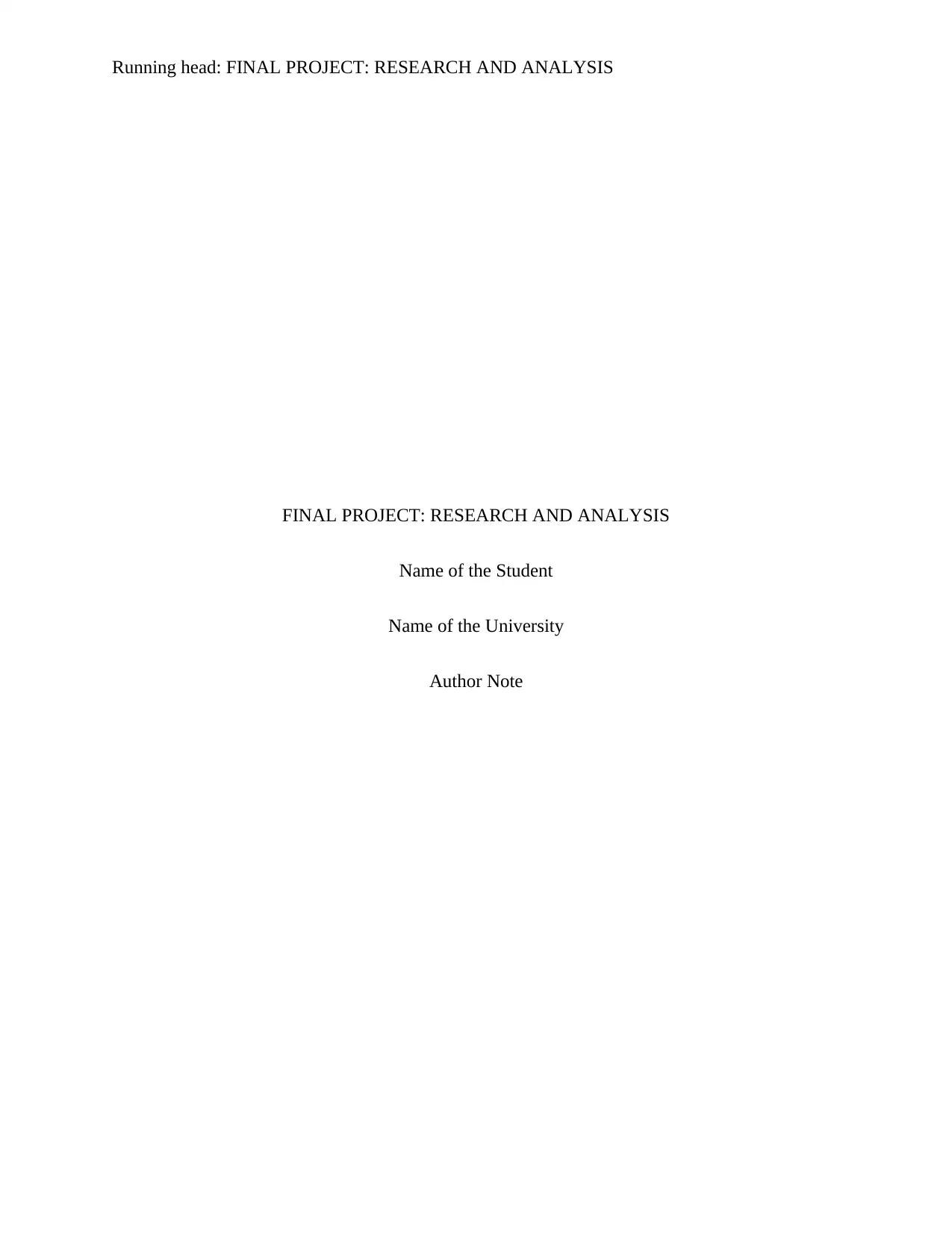
Running head: FINAL PROJECT: RESEARCH AND ANALYSIS
FINAL PROJECT: RESEARCH AND ANALYSIS
Name of the Student
Name of the University
Author Note
FINAL PROJECT: RESEARCH AND ANALYSIS
Name of the Student
Name of the University
Author Note
Paraphrase This Document
Need a fresh take? Get an instant paraphrase of this document with our AI Paraphraser
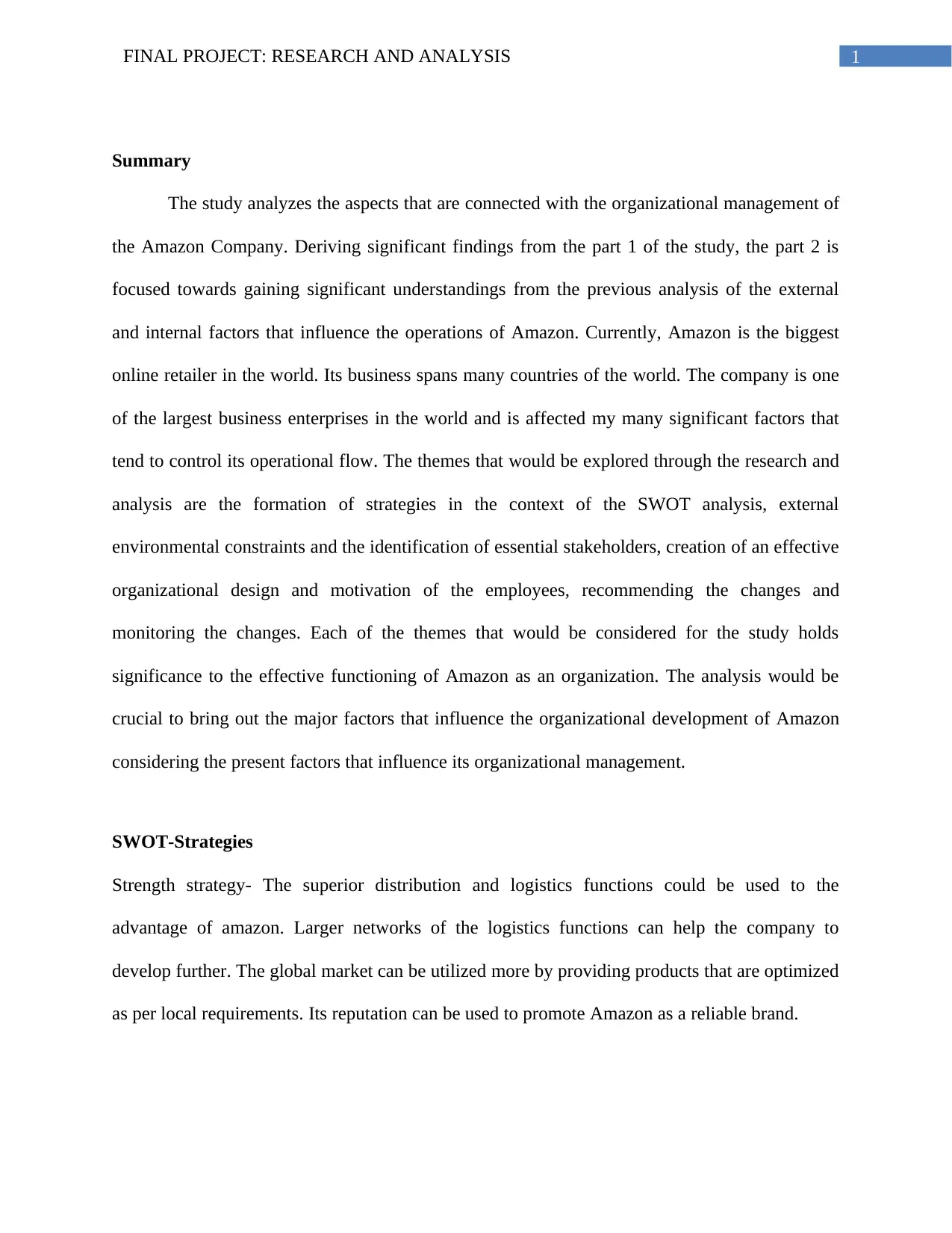
1FINAL PROJECT: RESEARCH AND ANALYSIS
Summary
The study analyzes the aspects that are connected with the organizational management of
the Amazon Company. Deriving significant findings from the part 1 of the study, the part 2 is
focused towards gaining significant understandings from the previous analysis of the external
and internal factors that influence the operations of Amazon. Currently, Amazon is the biggest
online retailer in the world. Its business spans many countries of the world. The company is one
of the largest business enterprises in the world and is affected my many significant factors that
tend to control its operational flow. The themes that would be explored through the research and
analysis are the formation of strategies in the context of the SWOT analysis, external
environmental constraints and the identification of essential stakeholders, creation of an effective
organizational design and motivation of the employees, recommending the changes and
monitoring the changes. Each of the themes that would be considered for the study holds
significance to the effective functioning of Amazon as an organization. The analysis would be
crucial to bring out the major factors that influence the organizational development of Amazon
considering the present factors that influence its organizational management.
SWOT-Strategies
Strength strategy- The superior distribution and logistics functions could be used to the
advantage of amazon. Larger networks of the logistics functions can help the company to
develop further. The global market can be utilized more by providing products that are optimized
as per local requirements. Its reputation can be used to promote Amazon as a reliable brand.
Summary
The study analyzes the aspects that are connected with the organizational management of
the Amazon Company. Deriving significant findings from the part 1 of the study, the part 2 is
focused towards gaining significant understandings from the previous analysis of the external
and internal factors that influence the operations of Amazon. Currently, Amazon is the biggest
online retailer in the world. Its business spans many countries of the world. The company is one
of the largest business enterprises in the world and is affected my many significant factors that
tend to control its operational flow. The themes that would be explored through the research and
analysis are the formation of strategies in the context of the SWOT analysis, external
environmental constraints and the identification of essential stakeholders, creation of an effective
organizational design and motivation of the employees, recommending the changes and
monitoring the changes. Each of the themes that would be considered for the study holds
significance to the effective functioning of Amazon as an organization. The analysis would be
crucial to bring out the major factors that influence the organizational development of Amazon
considering the present factors that influence its organizational management.
SWOT-Strategies
Strength strategy- The superior distribution and logistics functions could be used to the
advantage of amazon. Larger networks of the logistics functions can help the company to
develop further. The global market can be utilized more by providing products that are optimized
as per local requirements. Its reputation can be used to promote Amazon as a reliable brand.
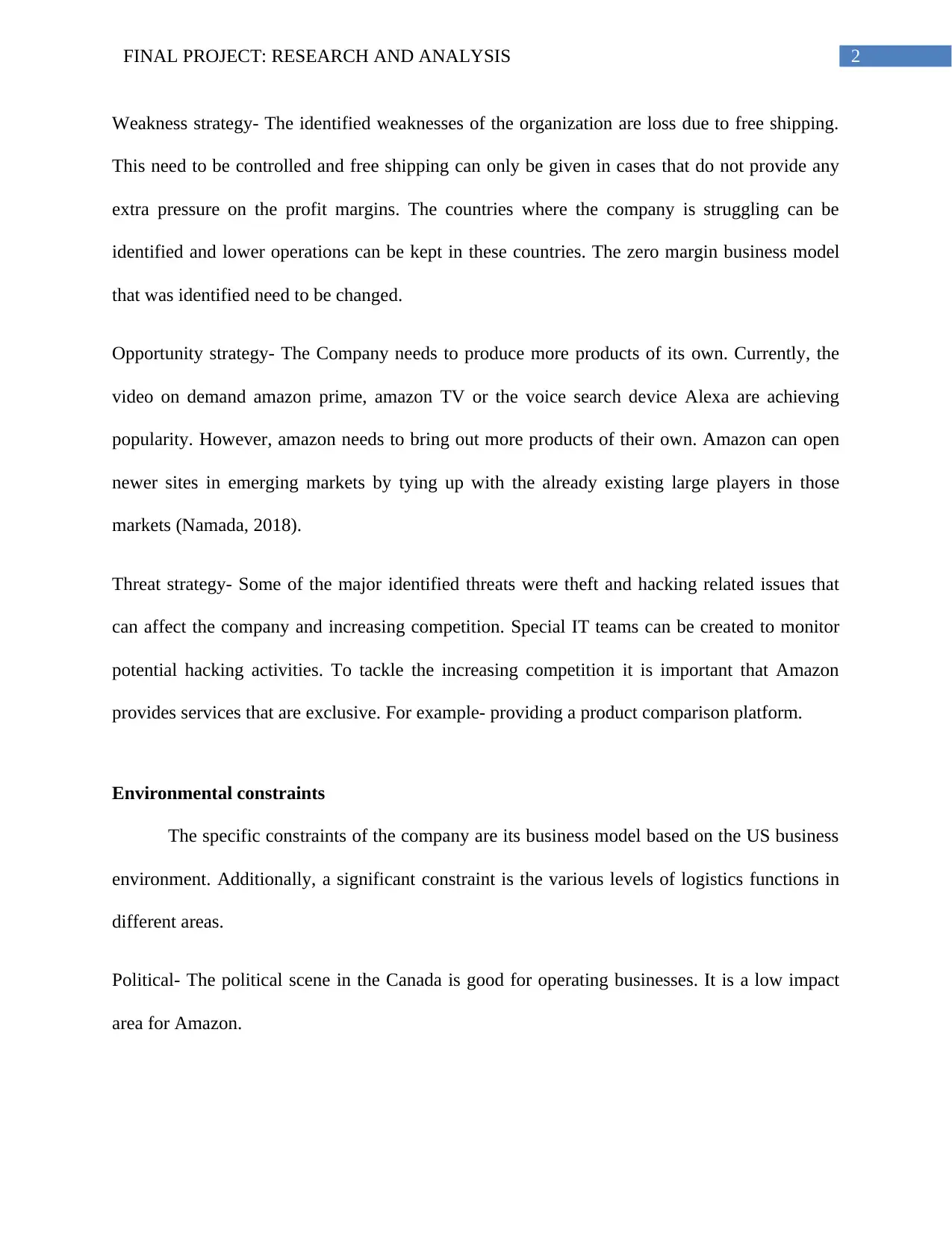
2FINAL PROJECT: RESEARCH AND ANALYSIS
Weakness strategy- The identified weaknesses of the organization are loss due to free shipping.
This need to be controlled and free shipping can only be given in cases that do not provide any
extra pressure on the profit margins. The countries where the company is struggling can be
identified and lower operations can be kept in these countries. The zero margin business model
that was identified need to be changed.
Opportunity strategy- The Company needs to produce more products of its own. Currently, the
video on demand amazon prime, amazon TV or the voice search device Alexa are achieving
popularity. However, amazon needs to bring out more products of their own. Amazon can open
newer sites in emerging markets by tying up with the already existing large players in those
markets (Namada, 2018).
Threat strategy- Some of the major identified threats were theft and hacking related issues that
can affect the company and increasing competition. Special IT teams can be created to monitor
potential hacking activities. To tackle the increasing competition it is important that Amazon
provides services that are exclusive. For example- providing a product comparison platform.
Environmental constraints
The specific constraints of the company are its business model based on the US business
environment. Additionally, a significant constraint is the various levels of logistics functions in
different areas.
Political- The political scene in the Canada is good for operating businesses. It is a low impact
area for Amazon.
Weakness strategy- The identified weaknesses of the organization are loss due to free shipping.
This need to be controlled and free shipping can only be given in cases that do not provide any
extra pressure on the profit margins. The countries where the company is struggling can be
identified and lower operations can be kept in these countries. The zero margin business model
that was identified need to be changed.
Opportunity strategy- The Company needs to produce more products of its own. Currently, the
video on demand amazon prime, amazon TV or the voice search device Alexa are achieving
popularity. However, amazon needs to bring out more products of their own. Amazon can open
newer sites in emerging markets by tying up with the already existing large players in those
markets (Namada, 2018).
Threat strategy- Some of the major identified threats were theft and hacking related issues that
can affect the company and increasing competition. Special IT teams can be created to monitor
potential hacking activities. To tackle the increasing competition it is important that Amazon
provides services that are exclusive. For example- providing a product comparison platform.
Environmental constraints
The specific constraints of the company are its business model based on the US business
environment. Additionally, a significant constraint is the various levels of logistics functions in
different areas.
Political- The political scene in the Canada is good for operating businesses. It is a low impact
area for Amazon.
⊘ This is a preview!⊘
Do you want full access?
Subscribe today to unlock all pages.

Trusted by 1+ million students worldwide
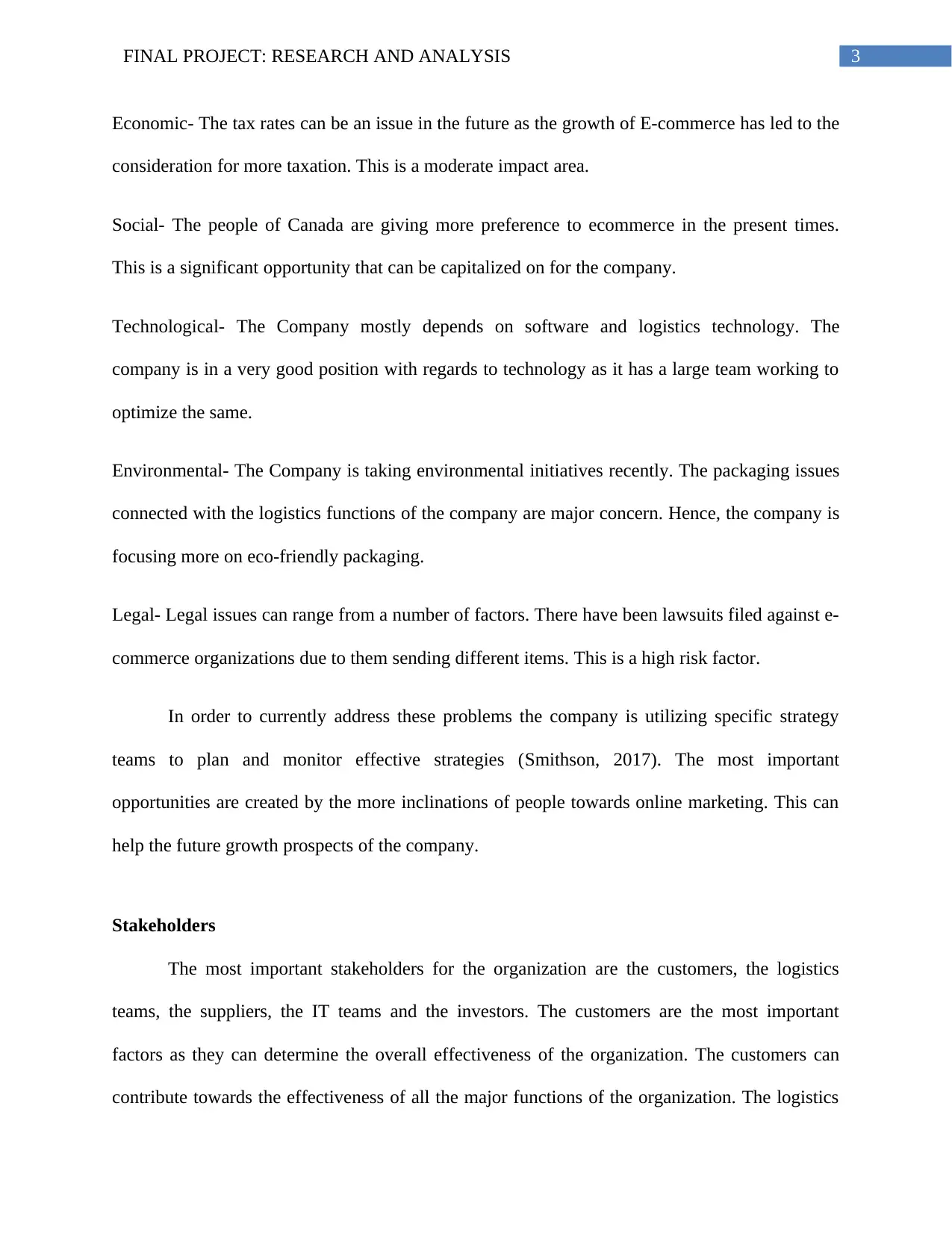
3FINAL PROJECT: RESEARCH AND ANALYSIS
Economic- The tax rates can be an issue in the future as the growth of E-commerce has led to the
consideration for more taxation. This is a moderate impact area.
Social- The people of Canada are giving more preference to ecommerce in the present times.
This is a significant opportunity that can be capitalized on for the company.
Technological- The Company mostly depends on software and logistics technology. The
company is in a very good position with regards to technology as it has a large team working to
optimize the same.
Environmental- The Company is taking environmental initiatives recently. The packaging issues
connected with the logistics functions of the company are major concern. Hence, the company is
focusing more on eco-friendly packaging.
Legal- Legal issues can range from a number of factors. There have been lawsuits filed against e-
commerce organizations due to them sending different items. This is a high risk factor.
In order to currently address these problems the company is utilizing specific strategy
teams to plan and monitor effective strategies (Smithson, 2017). The most important
opportunities are created by the more inclinations of people towards online marketing. This can
help the future growth prospects of the company.
Stakeholders
The most important stakeholders for the organization are the customers, the logistics
teams, the suppliers, the IT teams and the investors. The customers are the most important
factors as they can determine the overall effectiveness of the organization. The customers can
contribute towards the effectiveness of all the major functions of the organization. The logistics
Economic- The tax rates can be an issue in the future as the growth of E-commerce has led to the
consideration for more taxation. This is a moderate impact area.
Social- The people of Canada are giving more preference to ecommerce in the present times.
This is a significant opportunity that can be capitalized on for the company.
Technological- The Company mostly depends on software and logistics technology. The
company is in a very good position with regards to technology as it has a large team working to
optimize the same.
Environmental- The Company is taking environmental initiatives recently. The packaging issues
connected with the logistics functions of the company are major concern. Hence, the company is
focusing more on eco-friendly packaging.
Legal- Legal issues can range from a number of factors. There have been lawsuits filed against e-
commerce organizations due to them sending different items. This is a high risk factor.
In order to currently address these problems the company is utilizing specific strategy
teams to plan and monitor effective strategies (Smithson, 2017). The most important
opportunities are created by the more inclinations of people towards online marketing. This can
help the future growth prospects of the company.
Stakeholders
The most important stakeholders for the organization are the customers, the logistics
teams, the suppliers, the IT teams and the investors. The customers are the most important
factors as they can determine the overall effectiveness of the organization. The customers can
contribute towards the effectiveness of all the major functions of the organization. The logistics
Paraphrase This Document
Need a fresh take? Get an instant paraphrase of this document with our AI Paraphraser
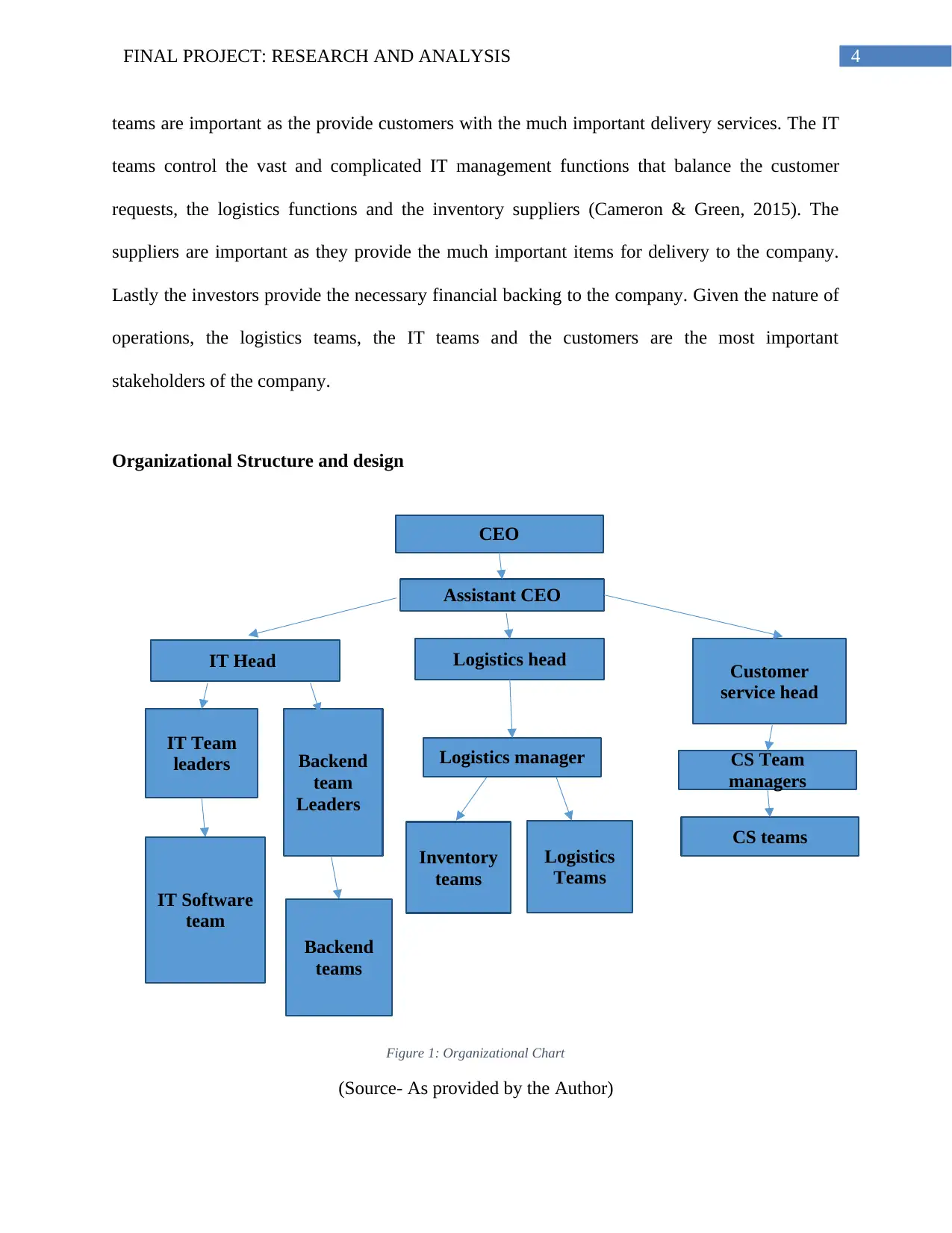
4FINAL PROJECT: RESEARCH AND ANALYSIS
CEO
Assistant CEO
IT Head Logistics head Customer
service head
IT Team
leaders
IT Software
team
Inventory
teams
CS Team
managers
CS teams
Logistics
Teams
Backend
team
Leaders
Backend
teams
Logistics manager
teams are important as the provide customers with the much important delivery services. The IT
teams control the vast and complicated IT management functions that balance the customer
requests, the logistics functions and the inventory suppliers (Cameron & Green, 2015). The
suppliers are important as they provide the much important items for delivery to the company.
Lastly the investors provide the necessary financial backing to the company. Given the nature of
operations, the logistics teams, the IT teams and the customers are the most important
stakeholders of the company.
Organizational Structure and design
Figure 1: Organizational Chart
(Source- As provided by the Author)
CEO
Assistant CEO
IT Head Logistics head Customer
service head
IT Team
leaders
IT Software
team
Inventory
teams
CS Team
managers
CS teams
Logistics
Teams
Backend
team
Leaders
Backend
teams
Logistics manager
teams are important as the provide customers with the much important delivery services. The IT
teams control the vast and complicated IT management functions that balance the customer
requests, the logistics functions and the inventory suppliers (Cameron & Green, 2015). The
suppliers are important as they provide the much important items for delivery to the company.
Lastly the investors provide the necessary financial backing to the company. Given the nature of
operations, the logistics teams, the IT teams and the customers are the most important
stakeholders of the company.
Organizational Structure and design
Figure 1: Organizational Chart
(Source- As provided by the Author)
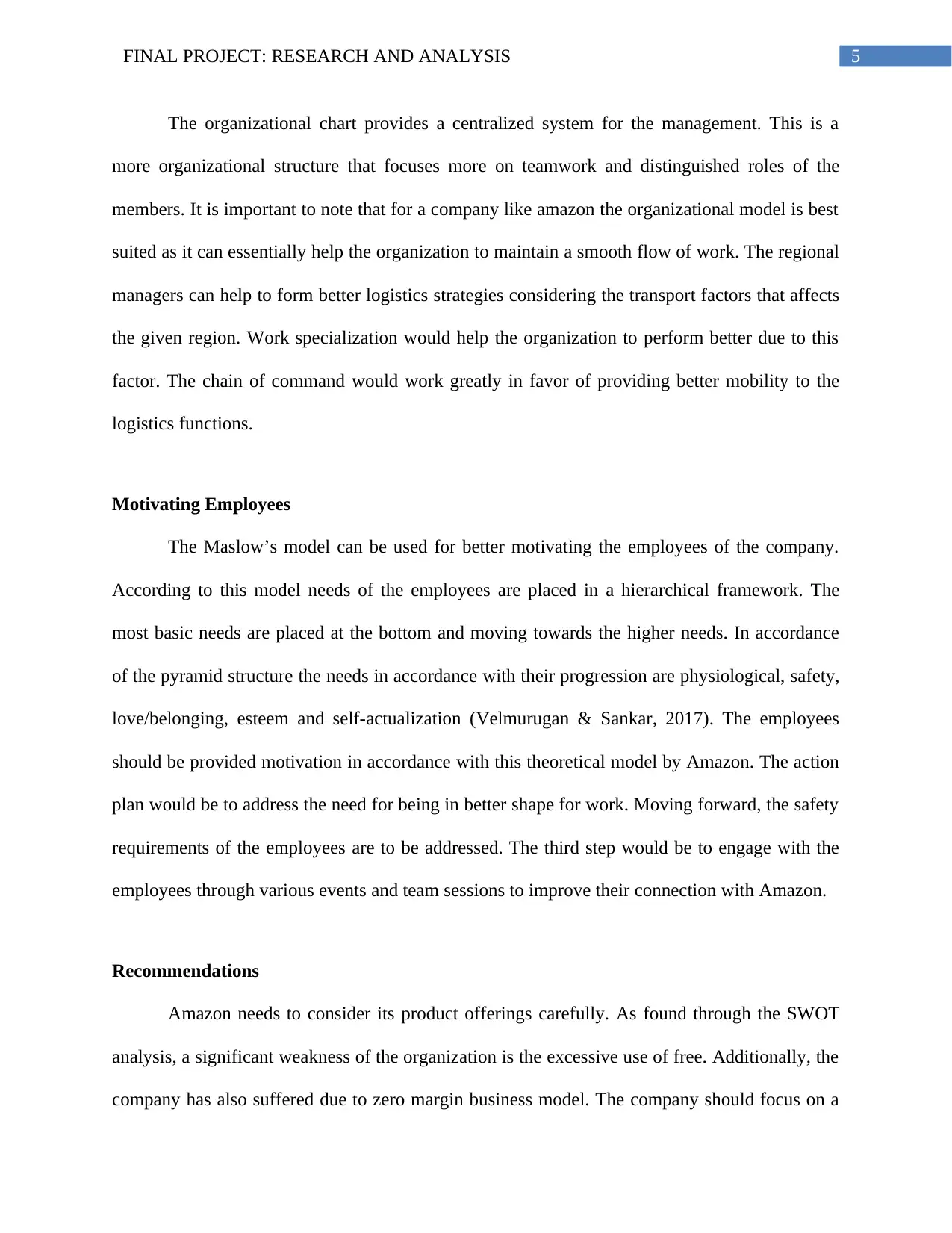
5FINAL PROJECT: RESEARCH AND ANALYSIS
The organizational chart provides a centralized system for the management. This is a
more organizational structure that focuses more on teamwork and distinguished roles of the
members. It is important to note that for a company like amazon the organizational model is best
suited as it can essentially help the organization to maintain a smooth flow of work. The regional
managers can help to form better logistics strategies considering the transport factors that affects
the given region. Work specialization would help the organization to perform better due to this
factor. The chain of command would work greatly in favor of providing better mobility to the
logistics functions.
Motivating Employees
The Maslow’s model can be used for better motivating the employees of the company.
According to this model needs of the employees are placed in a hierarchical framework. The
most basic needs are placed at the bottom and moving towards the higher needs. In accordance
of the pyramid structure the needs in accordance with their progression are physiological, safety,
love/belonging, esteem and self-actualization (Velmurugan & Sankar, 2017). The employees
should be provided motivation in accordance with this theoretical model by Amazon. The action
plan would be to address the need for being in better shape for work. Moving forward, the safety
requirements of the employees are to be addressed. The third step would be to engage with the
employees through various events and team sessions to improve their connection with Amazon.
Recommendations
Amazon needs to consider its product offerings carefully. As found through the SWOT
analysis, a significant weakness of the organization is the excessive use of free. Additionally, the
company has also suffered due to zero margin business model. The company should focus on a
The organizational chart provides a centralized system for the management. This is a
more organizational structure that focuses more on teamwork and distinguished roles of the
members. It is important to note that for a company like amazon the organizational model is best
suited as it can essentially help the organization to maintain a smooth flow of work. The regional
managers can help to form better logistics strategies considering the transport factors that affects
the given region. Work specialization would help the organization to perform better due to this
factor. The chain of command would work greatly in favor of providing better mobility to the
logistics functions.
Motivating Employees
The Maslow’s model can be used for better motivating the employees of the company.
According to this model needs of the employees are placed in a hierarchical framework. The
most basic needs are placed at the bottom and moving towards the higher needs. In accordance
of the pyramid structure the needs in accordance with their progression are physiological, safety,
love/belonging, esteem and self-actualization (Velmurugan & Sankar, 2017). The employees
should be provided motivation in accordance with this theoretical model by Amazon. The action
plan would be to address the need for being in better shape for work. Moving forward, the safety
requirements of the employees are to be addressed. The third step would be to engage with the
employees through various events and team sessions to improve their connection with Amazon.
Recommendations
Amazon needs to consider its product offerings carefully. As found through the SWOT
analysis, a significant weakness of the organization is the excessive use of free. Additionally, the
company has also suffered due to zero margin business model. The company should focus on a
⊘ This is a preview!⊘
Do you want full access?
Subscribe today to unlock all pages.

Trusted by 1+ million students worldwide
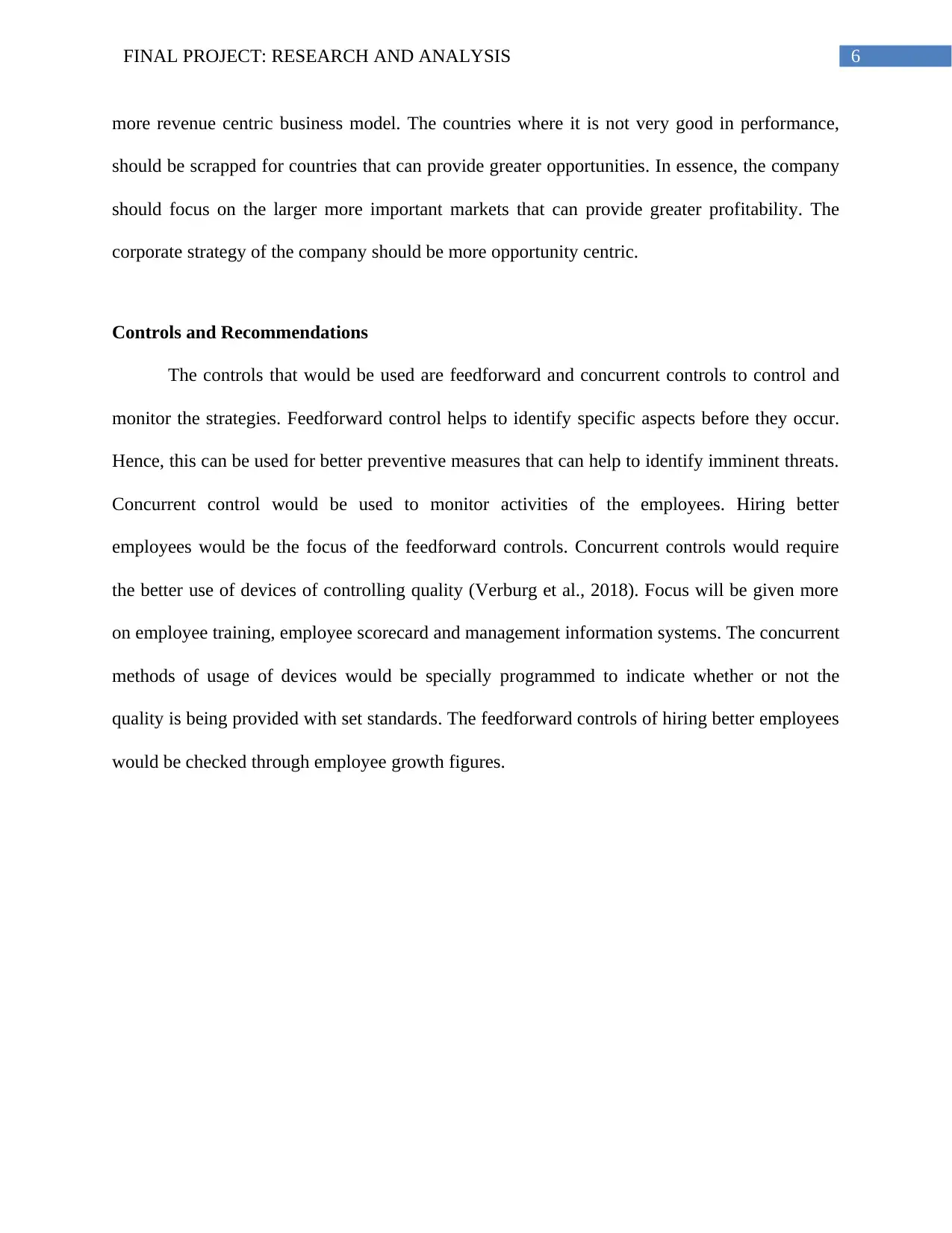
6FINAL PROJECT: RESEARCH AND ANALYSIS
more revenue centric business model. The countries where it is not very good in performance,
should be scrapped for countries that can provide greater opportunities. In essence, the company
should focus on the larger more important markets that can provide greater profitability. The
corporate strategy of the company should be more opportunity centric.
Controls and Recommendations
The controls that would be used are feedforward and concurrent controls to control and
monitor the strategies. Feedforward control helps to identify specific aspects before they occur.
Hence, this can be used for better preventive measures that can help to identify imminent threats.
Concurrent control would be used to monitor activities of the employees. Hiring better
employees would be the focus of the feedforward controls. Concurrent controls would require
the better use of devices of controlling quality (Verburg et al., 2018). Focus will be given more
on employee training, employee scorecard and management information systems. The concurrent
methods of usage of devices would be specially programmed to indicate whether or not the
quality is being provided with set standards. The feedforward controls of hiring better employees
would be checked through employee growth figures.
more revenue centric business model. The countries where it is not very good in performance,
should be scrapped for countries that can provide greater opportunities. In essence, the company
should focus on the larger more important markets that can provide greater profitability. The
corporate strategy of the company should be more opportunity centric.
Controls and Recommendations
The controls that would be used are feedforward and concurrent controls to control and
monitor the strategies. Feedforward control helps to identify specific aspects before they occur.
Hence, this can be used for better preventive measures that can help to identify imminent threats.
Concurrent control would be used to monitor activities of the employees. Hiring better
employees would be the focus of the feedforward controls. Concurrent controls would require
the better use of devices of controlling quality (Verburg et al., 2018). Focus will be given more
on employee training, employee scorecard and management information systems. The concurrent
methods of usage of devices would be specially programmed to indicate whether or not the
quality is being provided with set standards. The feedforward controls of hiring better employees
would be checked through employee growth figures.
Paraphrase This Document
Need a fresh take? Get an instant paraphrase of this document with our AI Paraphraser
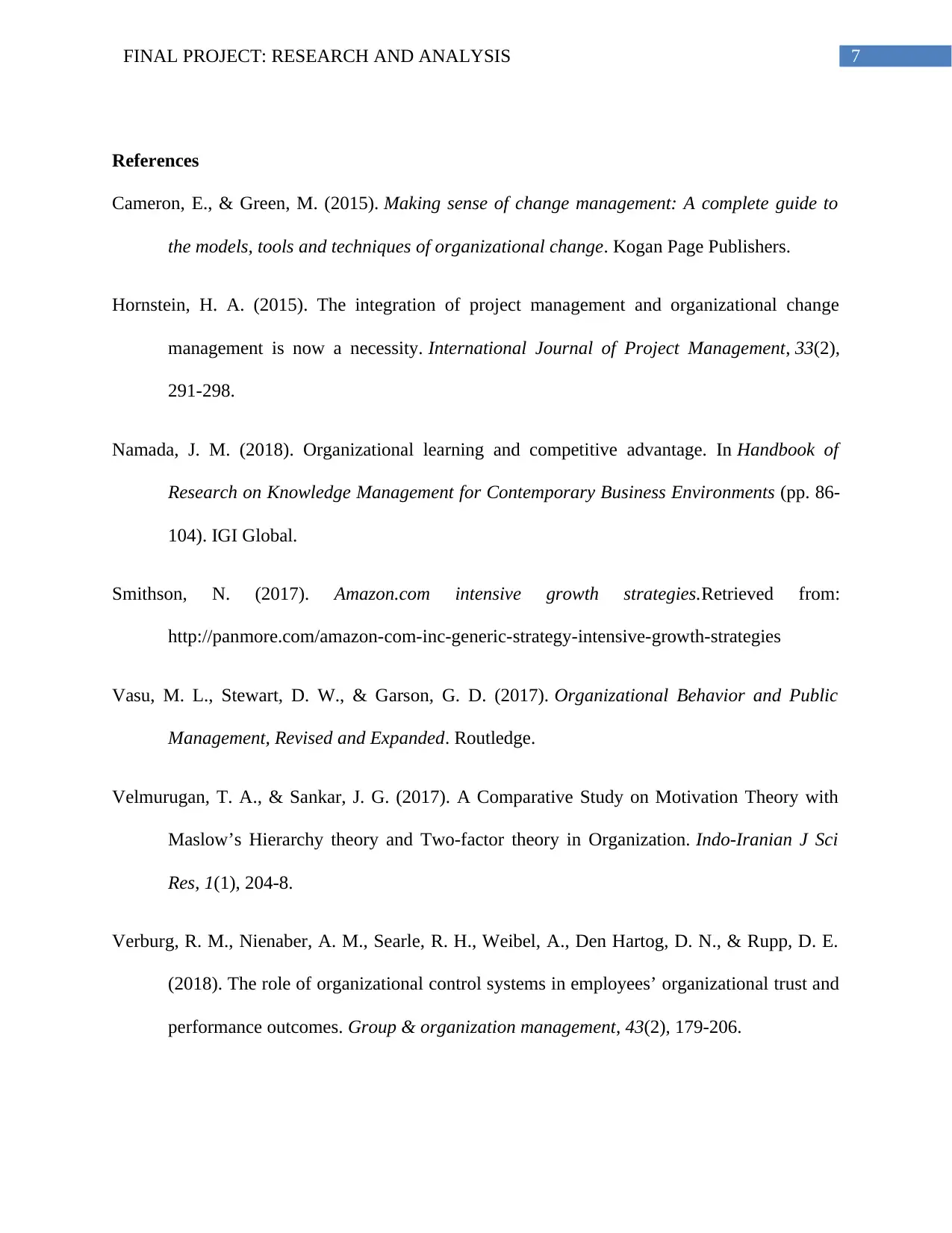
7FINAL PROJECT: RESEARCH AND ANALYSIS
References
Cameron, E., & Green, M. (2015). Making sense of change management: A complete guide to
the models, tools and techniques of organizational change. Kogan Page Publishers.
Hornstein, H. A. (2015). The integration of project management and organizational change
management is now a necessity. International Journal of Project Management, 33(2),
291-298.
Namada, J. M. (2018). Organizational learning and competitive advantage. In Handbook of
Research on Knowledge Management for Contemporary Business Environments (pp. 86-
104). IGI Global.
Smithson, N. (2017). Amazon.com intensive growth strategies.Retrieved from:
http://panmore.com/amazon-com-inc-generic-strategy-intensive-growth-strategies
Vasu, M. L., Stewart, D. W., & Garson, G. D. (2017). Organizational Behavior and Public
Management, Revised and Expanded. Routledge.
Velmurugan, T. A., & Sankar, J. G. (2017). A Comparative Study on Motivation Theory with
Maslow’s Hierarchy theory and Two-factor theory in Organization. Indo-Iranian J Sci
Res, 1(1), 204-8.
Verburg, R. M., Nienaber, A. M., Searle, R. H., Weibel, A., Den Hartog, D. N., & Rupp, D. E.
(2018). The role of organizational control systems in employees’ organizational trust and
performance outcomes. Group & organization management, 43(2), 179-206.
References
Cameron, E., & Green, M. (2015). Making sense of change management: A complete guide to
the models, tools and techniques of organizational change. Kogan Page Publishers.
Hornstein, H. A. (2015). The integration of project management and organizational change
management is now a necessity. International Journal of Project Management, 33(2),
291-298.
Namada, J. M. (2018). Organizational learning and competitive advantage. In Handbook of
Research on Knowledge Management for Contemporary Business Environments (pp. 86-
104). IGI Global.
Smithson, N. (2017). Amazon.com intensive growth strategies.Retrieved from:
http://panmore.com/amazon-com-inc-generic-strategy-intensive-growth-strategies
Vasu, M. L., Stewart, D. W., & Garson, G. D. (2017). Organizational Behavior and Public
Management, Revised and Expanded. Routledge.
Velmurugan, T. A., & Sankar, J. G. (2017). A Comparative Study on Motivation Theory with
Maslow’s Hierarchy theory and Two-factor theory in Organization. Indo-Iranian J Sci
Res, 1(1), 204-8.
Verburg, R. M., Nienaber, A. M., Searle, R. H., Weibel, A., Den Hartog, D. N., & Rupp, D. E.
(2018). The role of organizational control systems in employees’ organizational trust and
performance outcomes. Group & organization management, 43(2), 179-206.
1 out of 8
Related Documents
Your All-in-One AI-Powered Toolkit for Academic Success.
+13062052269
info@desklib.com
Available 24*7 on WhatsApp / Email
![[object Object]](/_next/static/media/star-bottom.7253800d.svg)
Unlock your academic potential
Copyright © 2020–2025 A2Z Services. All Rights Reserved. Developed and managed by ZUCOL.





